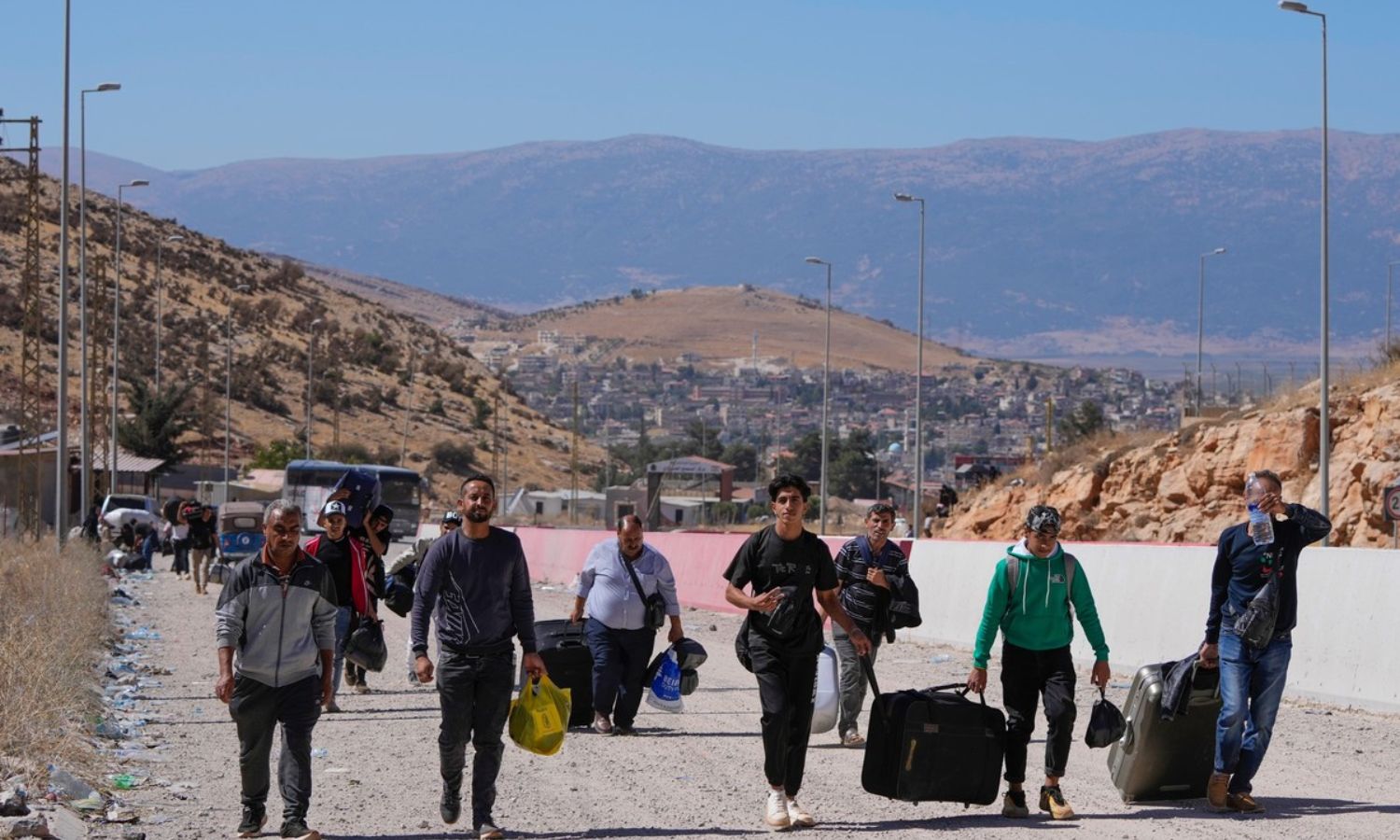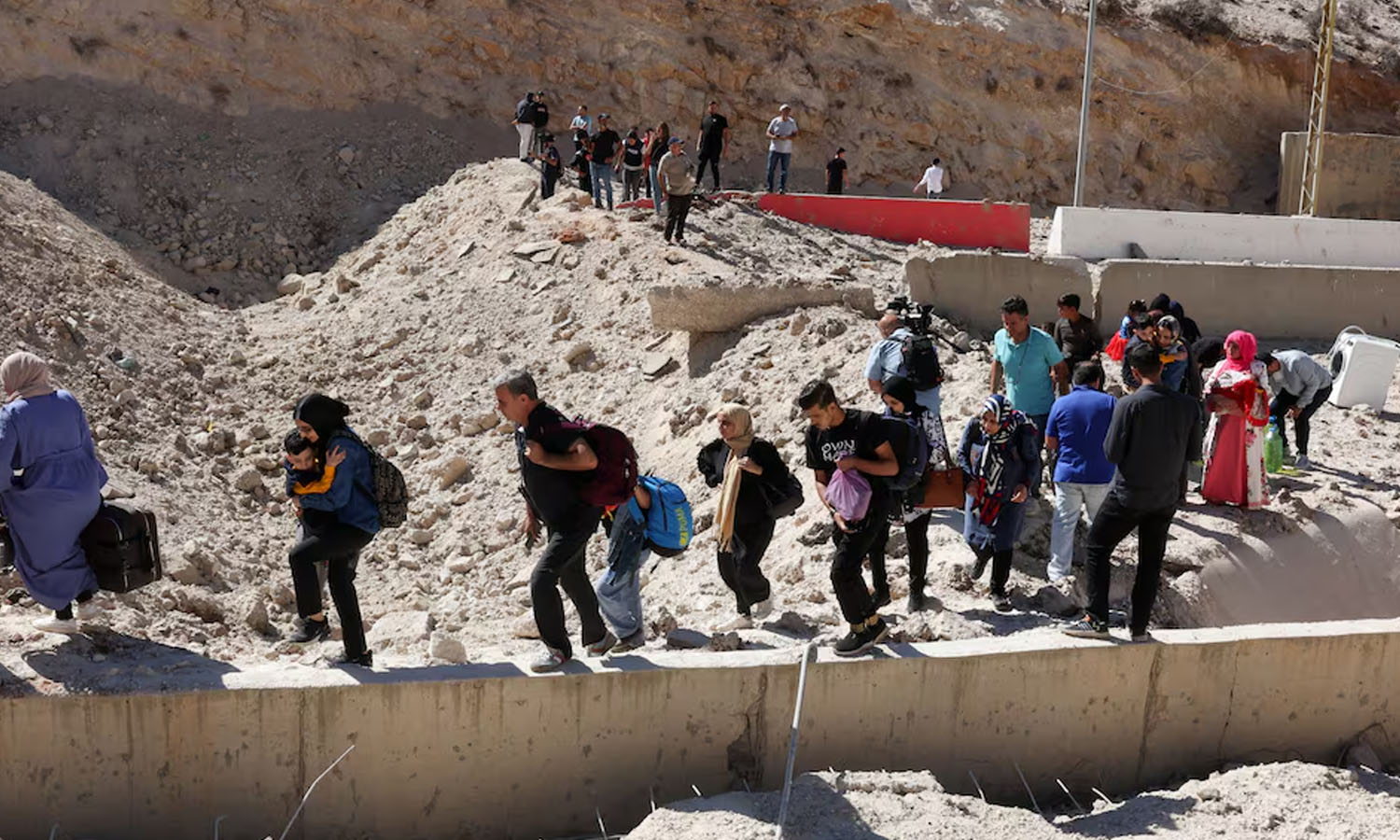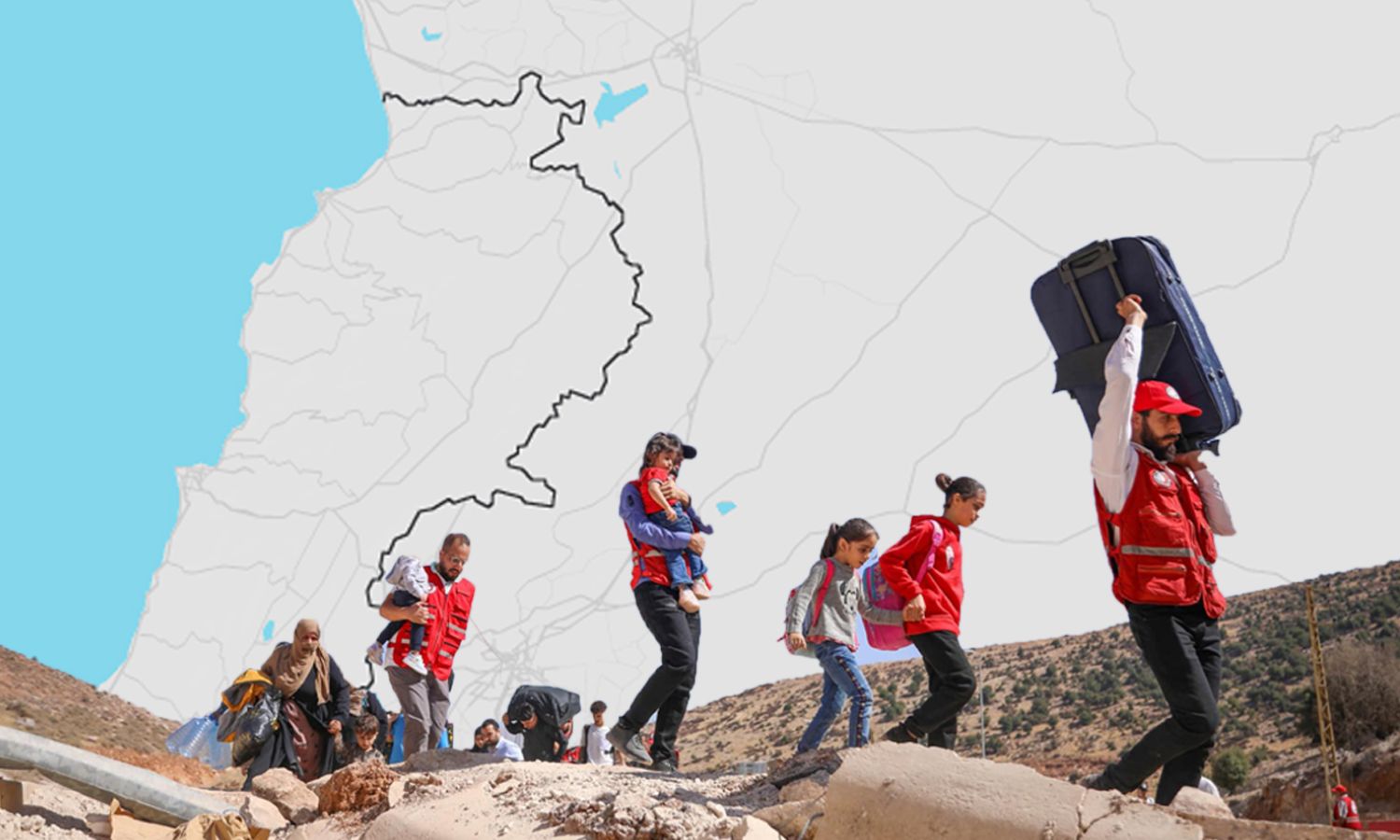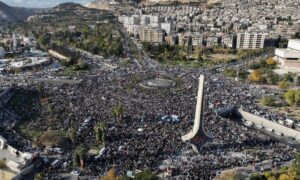Khaled al-Jeratli | Ali Darwish | Jana al-Issa
Along the 375-kilometer border strip between Lebanon and Syria, there has been a surge in the movement of displaced persons and refugees fleeing the Israeli military operations in Lebanon, seeing Syria as the only possible land route for refuge.
On the Syrian side of the border, crises create opportunities, as the Assad regime is anticipating political and economic margins for maneuvering, aiming for its government and institutions to be partners in managing regional crises. It seeks to obtain assistance to slightly fill gaps in the shattered economy and support a system based on distributing benefits among warlords.
With the early days of the displacement from Lebanon, the Syrian regime shifted its previous conditions for the return of Syrian refugees. After years of rejecting their return due to the alleged lack of infrastructure and the need to start reconstruction before accepting returnees, the government turned to facilitate the entry of hundreds of thousands of Syrians and Lebanese arriving at the border.
However, the lack of service capabilities, deteriorating economic conditions, security situation, and the capacities of Syrian institutions may not enable the absorption of large numbers of refugees.
Additionally, the military operations in Lebanon, along with Israeli attacks on border crossings along the Syria-Lebanon border, have affected the already limited trade movement in Syria, compounded by difficulties stemming from strained relations with neighboring countries and the constraints of Western sanctions, which have allowed Syrian officials to find a way around them in Lebanon.
While the future of the Syrian front cannot be predicted militarily, the impact of the war in Lebanon is beginning to show economically in Syria. Experts and researchers believe that aid may have a positive impact on the regime, which has been labeled in recent years as misappropriating aid and restricting its access to beneficiaries based on political grounds. However, the return of refugees and the disruption of trade routes with Lebanon may leave a negative imprint on the Syrian economy.
Syria: Aid’s black hole
About two years ago, the United Nations and international entities began again to engage with the Syrian regime regarding delivering assistance to Syrians, following repeated accusations against the regime of exploiting aid and failing to deliver it to those in need.
The growing accusations did not deter these entities from the mechanisms of delivering assistance via the regime over the past two years, specifically regarding aid that reached Syria after the February 2023 earthquake, and then discussions that started in September regarding the displaced Syrian and Lebanese who crossed the border from Lebanon to Syria.
On October 8, the United Nations High Commissioner for Refugees, Filippo Grandi, called for a plea to secure $324 million to help all those fleeing from Lebanon to Syria.
This came during a visit he made to Damascus, where he met with the Syrian regime’s president Bashar al-Assad, Foreign Minister Bassam Sabbagh, and other Syrian officials to discuss ways to support the new arrivals upon entering Syria, according to the UN Office for the Coordination of Humanitarian Affairs (OCHA).
On October 2, the European Union announced immediate emergency funding of €500,000 to the United Nations High Commissioner for Refugees (UNHCR) to support the response operations for those fleeing from Lebanon to Syria.
According to the EU’s official website, the financial assistance will meet humanitarian needs in Syria for six months.

Displaced individuals from Lebanon to Syria continue their journey on foot after Israel bombed the Masnaa crossing – October 4, 2024 (AP)
A track record
In October 2022, the Syrian Observatory of Political and Economic Networks (OPEN) and the Syrian Legal Development Program (SLDP) issued an investigation containing documents revealing that the United Nations provided approximately $137 million from its spending on purchases to Syrian companies owned by human rights violators, war beneficiaries, and individuals associated with the regime who are included on Western sanctions lists, among others linked to the Syrian regime, between 2019 and 2020.
According to the investigation, nearly a quarter of the analyzed UN funds went to companies owned by individuals who had been sanctioned by the United States or the UK due to their links to the Syrian regime or their involvement in the conflict.
Among these individuals are: Hashem al-Aqad, Samir Hassan, Fadi Saqr, Samer Foz, Ahmad Saber Hamsho, Ali Hamsho, Amr Hamsho, and Rania al-Dabbas.
The investigation added that about 47% of the UN’s spending on purchases during 2019 and 2020 went to companies with “high” or “very high” risk profiles, including war beneficiaries and individuals subjected to sanctions, as well as prominent allies of the regime, after excluding suppliers whose identities were not disclosed for “security” or “privacy” reasons.
Months after the investigation analyzing the regime’s benefit from aid in Syria, a devastating earthquake struck southern Turkey and northwestern Syria, resulting in thousands of deaths and injuries, along with significant destruction of infrastructure, leading to an influx of aid to Syria from all directions in the following months.
Despite the steady flow of aid to the areas under its control from the early days of the disaster, the regime also played a role in obstructing and delaying the entry of aid to northwestern Syria, culminating in a deal that became evident on the fifth day of the earthquake through a series of simultaneous decisions that allowed aid to enter and Washington relieved the regime from specific sanctions under the Caesar Act for six months.
Aid keeps the regime afloat
There are no actual figures to clarify what role aid plays in the shadow economy of the Syrian regime, but observers believe that aid constitutes one of the reasons for the regime’s continued existence to this day.
Karam Shaar, director of the Syrian program at the Syrian Observatory of Political and Economic Networks and an economist, believes that the regime relies on aid manipulation as part of its survival.
Shaar stated to Enab Baladi that aid manipulation is not necessarily a financial process that benefits al-Assad directly or fills the Syrian state’s treasury, but rather it is an “instrument of politicization” where the closest class to the regime benefits first.
Shaar believes that the regime always seeks to politicize aid and benefit from its circumstances, successfully doing so time and again. On another front, it works to keep its supporting class that aids its survival satisfied by allowing them to secure supply contracts or service agreements.
Shaar pointed to a report issued by the Syrian Observatory of Political and Economic Networks which concluded that 31% of the value of UN supplies from areas under regime control came from individuals sanctioned by the US, UK, or the EU, which is perceived as benefits for the supporting class of the regime from the aid.
The researcher sees that the aid being discussed recently is both negative and positive, noting that there will be a humanitarian response in Syria, especially since previously available funds had drastically decreased.
Furthermore, the regime still deals with humanitarian aid in a manner reminiscent of “arm-twisting,” based on a single principle: “If you want to feed the hungry, you must feed me too, and I will not allow you to feed anyone else otherwise.”

The Syrian Arab Red Crescent unloads cargo from an Emirati aid plane – February 20, 2023 (Syrian Arab Red Crescent/Facebook)
Taking advantage of crisis
The enthusiasm of the Syrian regime in welcoming those fleeing from Lebanon marks a shift in its policy that it has adhered to for years, as it has long rejected the return of Syrians, citing a lack of infrastructure in Syria and an inability to accommodate nearly two million Syrians living on Lebanese territory.
This enthusiasm stems from the regime’s readiness to take advantage of the current situation. Economically, the regime will capitalize on the issue of receiving displaced persons and refugees, considering it a goodwill gesture towards the international community, but it will demand a price in return, which, for the regime, could be the lifting of sanctions to facilitate the reception of the displaced, according to Dr. Firas Shaabo, an economist, speaking to Enab Baladi.
Shaabo believes that obtaining funding and receiving UN aid will be the primary outcomes of welcoming the displaced. It is expected that millions of dollars, if not hundreds of millions, will flow into Syria to facilitate support for the displaced.
Shaabo noted that the regime has a long history of manipulating aid, the latest of which involved the mishandling of earthquake relief when assistance reached Syria.
From exporting refugees to welcoming them
In 2020, the first announcement regarding a conference for the return of Syrian refugees was made from Moscow, not Damascus, and with it began the initial official discussions by the Syrian regime on this issue.
Although the international community recognizes that the regime holds the keys to the return of refugees to Syria, as previously stated by the US embassy in Damascus, the regime showed little interest in this reality, continuing negotiations on the refugee file, seeking to lift sanctions and achieve reconstruction of Syria under its control.
In July 2023, al-Assad met with Jordanian Foreign Minister Ayman Safadi during the latter’s visit to Damascus, where the topic of Syrian refugees in Jordan was raised.
Al-Assad linked the matter of the return of refugees to the deteriorating conditions in areas under his control, stating that the return of refugees is a priority, with the need to secure the necessary infrastructure for this return and the requirements for reconstruction and rehabilitation in all its forms.
“The safe return of refugees is a priority, along with securing the necessary infrastructure for this return and the requirements for reconstruction and rehabilitation in all its forms, supported by early recovery projects that enable returnees to restore their normal livelihoods.”
Syrian regime president Bashar al-Assad
With the beginning of the return of refugees and the displacement of thousands of Lebanese to Syria, the obstacles that al-Assad had long placed in front of the return project began to dissolve. Waves of Syrian and Lebanese families have been moving towards official and unofficial border crossings between Syria and Lebanon in search of a safe place away from Israeli bombardment, especially after its escalation in several Lebanese areas since September 21.
Syria exported 6.8 million refugees, according to UN figures, who are distributed across 125 countries worldwide, with children making up over 47% of that number. However, it has now become a destination for receiving Syrian refugees from Lebanon as well as tens of thousands of Lebanese, particularly from the southern areas, southern suburbs of Beirut, and Bekaa Valley.
No capacity in Syria
The regime promotes its activity in receiving arrivals from Lebanon through tools and institutions under its umbrella, whether the Syrian Arab Red Crescent (SARC) or the Syria Trust for Development and other institutions.
Ayman al-Dusouki, a researcher in local governance and political economy at the Omran Center for Strategic Studies, does not see that the economic situation, services, security conditions, and the capabilities of the Syrian regime’s institutions enable it to absorb large numbers of returning Lebanese and Syrian displaced persons.
This may have driven many of them to remain unsettled in regime-controlled areas, seeking refuge in neighboring countries or areas beyond its control, according to al-Dusouki.
Opposition-controlled areas in northwest Syria have received around 2,700 returning Syrians from Lebanon as of October 10, while the regions controlled by the Autonomous Administration of North and East Syria (AANES) have welcomed 18,875 people.
Al-Dusouki explained to Enab Baladi that the regime’s capacity to receive more refugees is linked to several considerations, the most important of which is the political consideration and how it leverages the displacement issue as a card to break its imposed isolation and establish itself as an active partner for organizations and countries in addressing the displacement catastrophe and developing it into various forms of cooperation.
On the other hand, al-Dusouki highlighted the pressures exerted on the regime by its allies in the “Resistance Axis” regarding the reception of Lebanese displaced persons, and to what extent this could be a burden and increase friction zones with Israel, especially if among the displaced are elements from the Lebanese Hezbollah.
One cannot overlook the economic factor and the regime’s ability to secure funding from UN organizations and donor countries to face the burden of displacement, according to al-Dusouki.
Obstructing return
In 2020, the regime held the International Conference on the Return of Refugees, under Russian invitation and sponsorship, at the Conference Palace in Damascus. The conference was presented as “an attempt within the framework of government efforts to end the suffering of Syrians abroad who were displaced due to (terrorism).” According to the official state narrative, Syria has “not stopped calling on its citizens to return, especially after security and stability have returned to their country.”
At the conference, Syrian regime leader Bashar al-Assad spoke about the necessity of reintegrating Syrian refugees into their country following joint efforts to eliminate “terrorism.”
According to analysts’ comments and experts for Enab Baladi at the time, the conference was described as a “ruse” to circumvent the political process and a plea for the “compassion” of the international community, especially from countries burdened with refugees in Lebanon, Jordan, Iraq, and Turkey.
The conference saw many countries abstaining from attendance, including influential players in the Syrian refugee issue, such as Turkey, Jordan, and Egypt, as well as the United States (with the absence of any official relations with the Syrian regime), the European Union, and Canada.
Subsequent to the conference, attempts by Arab countries to improve relations with the regime took steps focusing on the return of Syrian refugees, a goal that was not achieved. Instead, returning refugees faced arrest, documented by human rights organizations.
International human rights organizations issued reports about the regime’s arrest operations against returning refugees, including a report from Amnesty International titled “You’re Going to Your Death” in September 2021 and a report from Human Rights Watch titled “Our Lives Are Like Death” in October 2021, nearly a year after the “Return of Refugees” conference was held.
On May 27, Amnesty International confirmed that human rights organizations unanimously agree that there is no place in Syria that can be considered safe for the return of refugees.
In early June, the Asharq Al-Awsat newspaper reported a Lebanese parliamentary source stating that around 1,100 Syrians who returned voluntarily to their towns were officially sent back to Lebanon by the regime, and only 400 of them were allowed to return. The source noted that the regime classifies most of the displaced as unwanted and poses a security and demographic threat to its survival.
The Syrian Network for Human Rights (SNHR) documented, in a report released on June 20, during the World Refugee Day, at least 4,714 cases of arrests of returnees among refugees and displaced persons by Syrian regime forces from the beginning of 2014 until June 2024.
The report indicated that of the 4,714 cases of arrest, the regime has released only 2,402, leaving 2,312 individuals in detention, among which 1,521 have turned into enforced disappearances.
The arrests also targeted Syrians fleeing Israeli bombardment. During the period from September 23 to October 2, the SNHR documented the arrest of at least nine Syrian refugees, most of whom are from rural Damascus, on the grounds of “mandatory and reserve recruitment.”

Syrians and Lebanese crossing the border at the Masnaa crossing after its bombardment – October 4, 2024 (Reuters)
Escalation disrupts imports
The Jdeidet Yabous-Masnaa crossing in rural Damascus is the most important crossing between Syria and Lebanon. It was bombed by Israel on October 4, causing damage and cutting off the international road, thereby hindering the passage of vehicles.
The Lebanese Minister of Transport told Reuters that the bombing created a hole with a diameter of four meters and cut the road connecting Lebanon and Syria, which is used by hundreds of thousands fleeing from Israeli shelling, resulting in a disruption of movement across it.
The bombing of the crossing between Syria and Lebanon exacerbated the existing export problems in that sector in Syria.
The Masnaa crossing is the most prominent of the six legal crossings that connect Lebanon and Syria by land, frequently bombed by Israel under the pretext of disrupting the passage of Iranian weapons from Syria, which also threatens commercial movement.
The Israeli escalation in Lebanon will have a significant impact on the flow of locally produced goods in the upcoming period, especially since many of the raw materials used in their production are imported, which could raise prices unless a solution is found, according to Yasser Akreem, a member of the Damascus Chamber of Commerce.
Akreem stated to the local Al-Watan newspaper that due to the fears of importers (whether through Lebanon or elsewhere), consumer goods witnessed a significant contraction currently.
As Lebanon is a major source of petroleum derivatives sold on the roads, the tensions have led to a shortage of these materials, affecting transportation and work in workshops, especially for craftsmen who buy their petroleum derivatives at free market prices from the black market, according to Akreem.
Tied to the expansion of war
The economic repercussions of the escalation and the expansion of the war extend to Syria and the Middle East in general, amid concerns about instability in the global economy.
Sensitive economy
Ahmed Kaya, chief economist at the National Institute of Economic and Social Research in the United Kingdom, stated in a report published by the Business Insider site that the war in the Middle East could worsen instability in the global economy, increase uncertainty, harm efforts to combat inflation, and ultimately reduce global GDP growth.
He added that for the Syrian regime, Lebanese territories serve as a primary conduit for its imports, whether through official land crossings or ports, while several traders rely on Lebanon for various matters informally, including accessing their funds in foreign currency to smuggle into Syria.
Due to the geographical and political proximity between the two countries, the expansion of the war could lead to a flow of refugees and economic disturbances, including adverse economic impacts from the disruption of trade and movement across borders.
Moreover, the transit of smuggled goods through illegal crossings between the two countries is highly active, which fills local markets, according to Kaya.
According to a report published by the Middle East Institute in August 2020, the Syrian economy is sensitive to developments in Lebanon due to its heavy reliance on the Lebanese financial sector. Since the onset of the war in Syria, Syrian banks have lost most of their ability to access international financial markets, and transaction volumes have sharply declined.
Syrian individuals and institutions were among the main depositors in Lebanese banks, although the total volume of Syrian deposits is unclear, as the Lebanese Central Bank does not detail non-resident deposits by nationality.
It is also well-known that prominent Syrian businessmen have been using Lebanese tools to overcome international sanctions and access dollars in global markets, according to the report.
Syrian-Lebanese interconnection
What is happening in Lebanon cannot be separated from its repercussions on the Syrian economy, which was previously affected by the Beirut port explosion and the banking crisis, according to Syrian researcher in local governance and political economy at the Omaran Center for Strategic Studies, Ayman al-Dusouki.
Al-Dusouki stated in an interview with Enab Baladi that the situation is currently linked to the prolonged ongoing confrontations, their expansion, and the rising numbers of refugees arriving from Lebanon to Syria, noting that basic services are already insufficient, their quality is poor, and economic resources are scarce. Consequently, the movement of refugees will exert pressure on government services and increase the prices of essential goods.
The effects will be more evident if the supply chain of goods and materials coming to Syria via Lebanon is disrupted, further increasing economic pressures on the state and Syrian residents in areas under regime control.
In this context, al-Dusouki believes that there are alternatives available to the regime, but they are either economically costly or fraught with logistical challenges, or they require political steps such as relying on Turkey, which necessitates advancing the normalization process between the two countries.
The events in Lebanon may also affect the Syrian currency, according to al-Dusouki, but the extent and level of this impact depend on how the events affect access to hard currency and the demand for the Syrian pound.
Severe crisis
Syria heavily relies on Lebanon for trade and supplies, especially under the international sanctions imposed on the Syrian regime. The war in Lebanon has already disrupted these supplies, especially after the closure of the Jdeidet Yabous border crossing due to an Israeli airstrike.
The Syrian economy depends on the Lebanese financial sector, as many Syrians keep their funds in Lebanese banks. Therefore, the Syrian economy will suffer more in the coming period, according to economic researcher Radwan al-Dibs, as Lebanon is considered Syria’s “lung and main breathing space.”
Lebanon represents the primary source of foreign currency and serves as a route for smuggling oil to and from Syria. Moreover, Beirut Airport is a lifeline for Damascus Airport, as most flights arrive there before heading to Damascus, making it a key route for passenger movement to and from Syria.
The researcher pointed out that operations for smuggling arms, money, drugs, oil, and other materials are managed through unofficial crossings connecting Syria and Lebanon, which are controlled by Hezbollah on the Lebanese side and militia forces affiliated with the regime on the Syrian side.
As a result, Israel has targeted these crossings based on its intelligence information to limit the economic and military benefits exchanged between both sides, according to al-Dibs.
Alongside the targeting of the Jdeidet Yabous-Masnaa crossing in rural Damascus on October 4, recent Israeli airstrikes have focused on the crossings connecting Homs to Lebanese territory and along the border, particularly in the border area of al-Qusayr. They targeted villages such as Qasr, Matraba, Hosh al-Sayyid Ali, and Jarmash.
There are currently no alternatives for land import and export operations except through Iraq, which is not an official route but one that the regime is forced to use, according to al-Dibs. While the port of Tartus could be used as a maritime alternative, it is under Russian control and does not permit the kind of commercial and smuggling operations that the Lebanese borders allow.
The impact is still minor, but with the continuation of the war for months, the economic effects become increasingly evident, according to the researcher, who predicted that the “Syrian economy would face a severe crisis” translating into problems in both the oil and currency sectors, which are already subjected to repetitive shocks, alongside the availability of raw materials and others.
The researcher linked his expectations of a severe crisis to the Israeli military operation and its extension inside Lebanon, especially if the Israeli army manages to breach and reach the Litani River in Lebanon. A potential ceasefire in Lebanon might be the key to overcoming the economic shock.
if you think the article contain wrong information or you have additional details Send Correction
النسخة العربية من المقال
-
Follow us :
Most viewed
- Printing Syrian currency in Europe... A file on the table
- Complex steps to establish new Syrian army
- National Security Council in Syria: A necessity imposed by reality
- SDF-Damascus agreement in Aleppo: A test balloon for broader consensus
- Why establishing a ministry of emergencies and disasters in Syria is crucial













 The Syrian regime is looking to gain economic and political advantages by welcoming fleeing Syrians and Lebanese from Israeli bombardments (Enab Baladi)
The Syrian regime is looking to gain economic and political advantages by welcoming fleeing Syrians and Lebanese from Israeli bombardments (Enab Baladi)





 A
A
A
A
A
A








 More In-Depth
More In-Depth